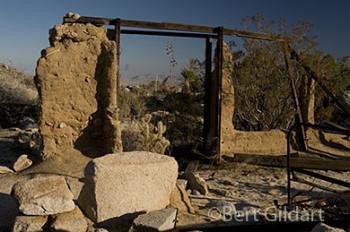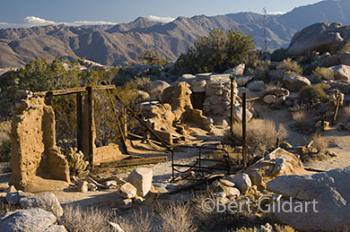Lessons From Yaquitepec
©Bert Gildart: The trail was steep and rocky, and following a one-hour hike, Janie and I finally reached Yaquitepec, the site of the eroding ruins of a home Marshall South and his wife Tanya began building in February 1930. Here they remained until September 1946.
They had removed themselves from civilization hoping their lifestyle of simplicity would complement the flood of writing that both Tanya and Marshall produced. What we found, however, as we poked around the old homestead now being absorbed by the overwhelming wilderness in which they had once worked, were ruins. And they were a metaphor for their “experiment.”
For awhile, all seemed to go well for the Souths. Three children were conceived here, and art work produced. In his years at Yaquitepec Marshall wrote hundreds of magazine stories. “They were popular,” wrote Randall Henderson, editor of Desert Magazine, “because he expressed the dreams which are more or less in the hearts of all imaginative people.” Often complementing those stories was Tanya’s poetry. Marshall also wrote five novels, all popular at the time.
INFLEXIBLE NATURE
But underlying all of these achievements was an inflexible nature, and that, more than anything else, probably contributed to their downfall. Wrote Henderson in a book we had carried in our day-pack to Yaquitepec: “Marshall’s tragedy was that he tried too hard to fulfill his dream. He would not compromise. And that is fatal in a civilization where life is a never-ending compromise between the things we would like to do and the obligations imposed by the society and economic organization of which we are a part…
“He wanted to raise a family–and impose upon his family his own unconventional way of life.”
Though Henderson may well have been correct, the Souths were living in a time when vast changes were occurring. Our nation was at war and the army considered a part of the land on which the South’s were living to be their land, and in 1945, forced them off. Though permitted to return a year later, the South’s way of life had been disrupted, momentum lost, and they had to start all over again. By this time, the toll of such Spartan existence was taking its toll on Tanya, and she wanted out.
TRAGIC ENDINGS
One winter day she gathered the children and marched down from Ghost Mountain, eventually settling in San Diego. Though there is much in the records to suggest she often looked back during the next 50 years (she died in 1997 at age 99), there is little in the written record, for she remained aloof–and sometimes friendless.
Marshall died in 1948, at the age of 59. He was penniless and so destitute that it remained for Rider, his oldest child, to provide a marker, which he did in 2005. The epitaph read: “Father, Poet, Author, Artist and included as well, one of his poems. Though the poem that follows is not the one on the grave stone, it may well reflect Marshall’s hopes that he did, indeed, leave his mark. The poem is entitled TIME and we begin with his second stanza:
Who owns this land? Beneath the sun,
in blots of indigo and dun,
The shadows of the clouds move by,
beneath the arch of turquoise sky.
Sunlight and shade in patterned change
across the wasteland’s endless range-
Time–on soft feet. And who shall find,
the records we shall leave behind?
Janie and I closed the book about the Souths and continued poking around. Immediately we found the metal frame of the old bed that all five used in the winter for warmth. We could also make out the general layout of their home. We found evidence of the cisterns Marshall constructed to funnel water following the desert’s infrequent rains. But elsewhere agave poked throughout the old structure. So, too, did ocotillo and barrel cacti. Cholla blocked the frame once supporting a door.
EXPERIMENT’S LESSONS?
When Janie and I first learned about the couple, we had cheered for them; hoping to learn of a happy ending. But that was not to be, and we concluded they were lucky to have made it as long as they did, for so much was against them. They contended with war, disruptions to their lifestyle, and a society that at times expressed intolerance. As well, the nation was growing–the population expanding–and their land was coveted by some.
Without funds, they were ill equipped to fight this new battle, a lesson we should not forget. Take heart from the fact that their home-schooled children led very successful lives.
—-
4th ed. Autographed by the Authors
Hiking Shenandoah National Park
 Hiking Shenandoah National Park is the 4th edition of a favorite guide book, created by Bert & Janie, a professional husband-wife journalism team. Lots of updates including more waterfall trails, updated descriptions of confusing trail junctions, and new color photographs. New text describes more of the park’s compelling natural history. Often the descriptions are personal as the Gildarts have hiked virtually every single park trail, sometimes repeatedly.
Hiking Shenandoah National Park is the 4th edition of a favorite guide book, created by Bert & Janie, a professional husband-wife journalism team. Lots of updates including more waterfall trails, updated descriptions of confusing trail junctions, and new color photographs. New text describes more of the park’s compelling natural history. Often the descriptions are personal as the Gildarts have hiked virtually every single park trail, sometimes repeatedly.
Big Sky Country is beautiful
Montana Icons: 50 Classic Symbols of the Treasure State
![]() Montana Icons is a book for lovers of the western vista. Features photographs of fifty famous landmarks from what many call the “Last Best Place.” The book will make you feel homesick for Montana even if you already live here. Bert Gildart’s varied careers in Montana (Bus driver on an Indian reservation, a teacher, backcountry ranger, as well as a newspaper reporter, and photographer) have given him a special view of Montana, which he shares in this book. Share the view; click here.
Montana Icons is a book for lovers of the western vista. Features photographs of fifty famous landmarks from what many call the “Last Best Place.” The book will make you feel homesick for Montana even if you already live here. Bert Gildart’s varied careers in Montana (Bus driver on an Indian reservation, a teacher, backcountry ranger, as well as a newspaper reporter, and photographer) have given him a special view of Montana, which he shares in this book. Share the view; click here.
$16.95 + Autographed Copy
What makes Glacier, Glacier?
Glacier Icons: 50 Classic Views of the Crown of the Continent
![]() Glacier Icons: What makes Glacier Park so special? In this book you can discover the story behind fifty of this park’s most amazing features. With this entertaining collection of photos, anecdotes and little known facts, Bert Gildart will be your backcountry guide. A former Glacier backcountry ranger turned writer/photographer, his hundreds of stories and images have appeared in literally dozens of periodicals including Time/Life, Smithsonian, and Field & Stream. Take a look at Glacier Icons
Glacier Icons: What makes Glacier Park so special? In this book you can discover the story behind fifty of this park’s most amazing features. With this entertaining collection of photos, anecdotes and little known facts, Bert Gildart will be your backcountry guide. A former Glacier backcountry ranger turned writer/photographer, his hundreds of stories and images have appeared in literally dozens of periodicals including Time/Life, Smithsonian, and Field & Stream. Take a look at Glacier Icons
$16.95 + Autographed Copy




February 1st, 2008 at 12:41 pm
Bert I found this to be very interesting and wanted to find out more on the South’s. I’m Googling away at this very moment. lol
A sad ending to such a promising story.
Thank you for taking us up Ghost Mountain with you.
February 3rd, 2008 at 9:26 pm
Bert,
I enjoyed my hike up to the site last year as well. We’d stopped by last March, and read the interesting story of their experiment as well.
Great entry! I’m looking forward to returning there in a few weeks myself.
Rich
March 2nd, 2008 at 8:34 am
[...] you want to know more about the experiment of desert living, check out Bert’s Blog and Bill’s Blog. They’ll fill in the big details, and give you links to other places [...]
January 23rd, 2009 at 6:53 pm
[...] the ruins of Yaquitepec, recounted Marshal South’s story, and reflected on the “Lessons From Yaquitepec“. I also contemplated the story while sitting on Marshal South’s melting adobe [...]
December 27th, 2009 at 3:32 pm
It’s important to note that later in life, when the state of California contacted Tanya about creating a cultural preserve, she wrote back that “to honor the stark, miserable existence that Yaquitepec represented is quite absurd to me.”
March 3rd, 2011 at 4:33 pm
thanks for the photos..sure has changed since i last saw it, in mid-80’s…now melting away..so sad.
marker was put up cause around that time there was renewed interest and a book released. lame ass kid.